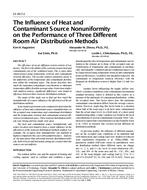Description
The efficiency of an air diffusion system consists of two factors. The first is the ability of the system to remove heat and contaminants out of the ventilated room. This is most often characterized using temperature removal and contaminant removal efficiency. The second, seldom considered, factor is the uniformity of the temperature and contaminant distribution within the ventilated space. This factor describes how much the maximum contaminant concentration or minimum temperature differs from the average value. In previous studies with uniform sources, significant differences were found in efficiency between three room air distribution methods. The target of this study was to find out how much the nonuniformity of a source influences the efficiencies of the air distribution methods. Scale model experiments were conducted to determine the influence of heat and contaminant source nonuniformities on the occupied zone temperature and contaminant distribution and the temperature removal and contaminant removal efficiencies in industrial space. Three room air distribution methods (one mixing and two zonal) were used. The heat and contaminant source nonuniformity and source location were found to have a major influence on the efficiencies of the room air distribution methods studied. For example, the occupied zone nonuniformity was fourfold at highest compared to the cases with a uniform source. Analysis of the data shows that with zonal room air distribution methods, both vertical and horizontal zoning are created when the sources are not uniform.
Units: Dual
Citation: Symposium, ASHRAE Transactions, vol. 105, pt. 2, Seattle 1999
Product Details
- Published:
- 1999
- Number of Pages:
- 9
- File Size:
- 1 file , 2.8 MB
- Product Code(s):
- D-7505




